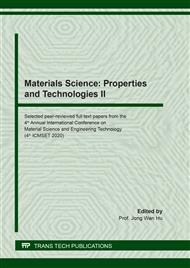[1]
L. G. de Vallejo, M. Ferrer, Geological Engineering, CRC Press, (2011).
Google Scholar
[2]
M. Ahmad, M. K. Ansari, R. Singh, L. K. Sharma, T. N. Singh, Assessment of Durability and Weathering State of Some Igneous and Metamorphic Rocks Using Micropetrographic Index and Rock Durability Indicators: A Case Study, Geotech. Geol. Eng. 35(2) (2017) 827-842.
DOI: 10.1007/s10706-016-0146-z
Google Scholar
[3]
K. Fuenkajorn, Experimental assessment of long-term durability of some weak rocks, Bull. Eng. Geol. Environ. 70(2) (2011) 203-211.
DOI: 10.1007/s10064-010-0297-8
Google Scholar
[4]
P. Paige-Green, Durability testing of basic crystalline rocks and specification for use as road base aggregate, Bull. Eng. Geol. Environ. 66(4) (2007) 431-440.
DOI: 10.1007/s10064-007-0088-z
Google Scholar
[5]
S. Yagiz, Correlation between slake durability and rock properties for some carbonate rocks, Bull. Eng. Geol. Environ. 70(3) (2011) 377-383.
DOI: 10.1007/s10064-010-0317-8
Google Scholar
[6]
W. Piasta, J. Góra, T. Turkiewicz, Properties and durability of coarse igneous rock aggregates and concretes, Constr. Build. Mater. 126 (2016) 119-129.
DOI: 10.1016/j.conbuildmat.2016.09.022
Google Scholar
[7]
S. Ceryan, New weathering indices for evaluating durability and weathering characterization of crystalline rock material: A case study from NE Turkey, J. African Earth Sci. 103 (2015) 54-64.
DOI: 10.1016/j.jafrearsci.2014.12.005
Google Scholar
[8]
M. Moradizadeh, A. Cheshomi, M. Ghafoori, S. TrighAzali, Correlation of equivalent quartz content, Slake durability index and Is50 with Cerchar abrasiveness index for different types of rock, Int. J. Rock Mech. Min. Sci. 86 (2016) 42-47.
DOI: 10.1016/j.ijrmms.2016.04.003
Google Scholar
[9]
G. Vlastelica, P. Miščević, N. Š. Cvitanović, Durability of soft rocks in Eocene flysch formation (Dalmatia, Croatia), Eng. Geol. 245 (2018) 207-217.
DOI: 10.1016/j.enggeo.2018.08.015
Google Scholar
[10]
M. U. Qureshi, I. Towhata, S. Yamada, Experimental relation between shear strength under low pressure and S-wave velocity of rock subjected to mechanical weathering, Soils Found. 59(5) (2019) 1468-1480.
DOI: 10.1016/j.sandf.2019.06.003
Google Scholar
[11]
S. Kahraman, M. Fener, O. Gunaydin, Estimating the uniaxial compressive strength of pyroclastic rocks from the slake durability index, Bull. Eng. Geol. Environ. 76(3) (2017) 1107-1115.
DOI: 10.1007/s10064-016-0893-3
Google Scholar
[12]
A. S. D18.12, Standard Test Method for Laboratory Method for Density, Relative Density (Specific Gravity), and Absorption of Coarse Aggregate ASTM C127-04, American Soc. Test. Mater. (2004).
DOI: 10.1520/c0127-88r01
Google Scholar
[13]
L. Navarro, W. Martínez, A. Espinoza, Materials Analysis, Handbook of Materials Analysis, Materials Resistance, (2011).
Google Scholar
[14]
A. D18.12, Standard Test Method for Slake Durability of Shales and Other Similar Weak Rocks, (2016).
DOI: 10.1520/d4644-04
Google Scholar
[15]
C. S. Rayat, Applications of Microsoft Excel in Statistical Methods, Statis Meth Medi Res, Springer, Singapore, (2018) 139-146.
Google Scholar
[16]
G. Shobha, S. Rangaswamy, Machine Learning, (2018) 197-228.
Google Scholar


